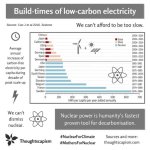What is the total energy production-consumption of the USA including gasoline per year in kwh versus the total potential for solar power in kwh? My guess is it will not be enough.
Gasoline has to be replaced by something other than fossil based electrify.
You can make gasoline (octane) from the CO
2 in air, Hydrogen electrolysed from water, plus process heat from high temperature/low pressure nuclear reactors, including molten fluoride salt, molten chloride salt, and lead or sodium cooled designs.
The Los Alamos National Laboratory's '
Green Freedom' proposal estimates that using GenIII PWRs to provide heat and electrical power, this could produce gasoline at $3.40 - $4.60 per gallon at the pump - with some minor design changes to the cooling towers such that the cooling water dissolves larger amounts of atmospheric CO
2, which can then be extracted from the water simultaneously with the electrolytic extraction of hydrogen.
About half of the cost is the cost of energy, and using a higher temperature GenIV reactor, fueled using cheap spent PWR fuel would allow those costs to be significantly lower - in the case of spent nuclear fuel (SNF) burning reactors, the PWR operators may well pay you to take the SNF off their hands, as it currently costs a fair amount to store (it is often referred to as 'High Level Waste', but this is a misnomer, as it is a valuable fuel resource for fast reactors).
Costs can also be dramatically lower if CO
2 is sourced from flue gas at gas or coal fired power plants and industrial facilities, rather than from air; This has the overall effect of getting twice the energy per molecule of CO
2 than if the flue gas were released directly to the atmosphere (as they are today) - which is a step in the right direction.
Probably the easiest way to implement such a system would be to start with facilities using flue gas from existing fossil fuel burners, and then transition to using CO
2 from air as those facilities themselves make the switch to other energy sources. Such sources should be competitive with fossil sourced gasoline, even without any 'carbon tax' being applied to fossil fuels.
'At the pump' prices can be even more competitive in high-tax nations (eg in Western Europe), where there is plenty of scope for tax breaks to be granted to zero emissions fuel.
A GenIV fast reactor should be able to extract about 36x the energy from SNF as was taken from it by the initial pass through a PWR or BWR; As SNF has been produced for ~60 years in the USA, and provided about 15-20% of the nation's power over that period, there is sufficient SNF available for more than 400 years of operations providing 100% of electrical power to the grid - or about 200 years of supplying both electricity and gasoline to meet the entire demand of the USA. That's bad news if you are a uranium miner - basically, we already mined enough Uranium to last half a millennium, but PWRs only burn about 4% of it. Fast reactors not only burn the other 96%, they also generate (and then burn) more fissile fuel in the process.
The half life of SNF is in the order of tens of thousands of years, which is why it's expensive to store; The half-life of the waste products from a GenIV fast reactor (eg the Elysium
Molten Chloride Salt Fast Reactor) should be in the order 80-100 years, as all of the long-lived fissionable actinides are burned up.
Of note in this thread is the rather casual comment in the Green Freedom proposal: "We have limited our studies to nuclear power
because its capital costs are lower than wind and solar-electric power, and it has significant environmental advantages over fossil energy sources, which are not carbon-neutral." (my emphasis).

